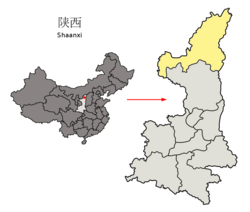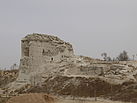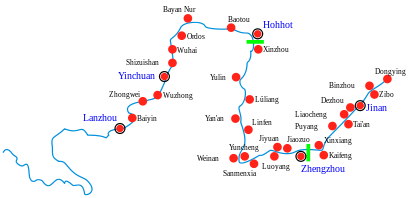Yulin, Shaanxi
Yulin
榆林市 | |
|---|---|
Clockwise from the top:
| |
 Location of Yulin City jurisdiction in Shaanxi | |
| Coordinates (Yulin municipal government): 38°17′09″N 109°44′03″E / 38.2858°N 109.7341°E | |
| Country | People's Republic of China |
| Province | Shaanxi |
| Municipal seat | Yuyang District |
| Area | |
• Total | 43,578 km2 (16,826 sq mi) |
| Elevation | 1,084 m (3,556 ft) |
| Population (2020)[1] | |
• Total | 3,634,750 |
| • Density | 83/km2 (220/sq mi) |
| GDP[2] | |
| • Total | CN¥ 249 billion US$ 40 billion |
| • Per capita | CN¥ 73,453 US$ 11,793 |
| Time zone | UTC+08:00 (China Standard) |
| ISO 3166 code | CN-SN-08 |
| Licence plates | 陕K |
| Website | yl |
Yulin (Chinese: 榆林; pinyin: Yúlín) is a prefecture-level city in the Shanbei region of Shaanxi province, China, bordering Inner Mongolia to the north, Shanxi to the east, and Ningxia to the west. It has an administrative area of 43,578 km2 (16,826 sq mi) and as of the 2020 Chinese census had a population of 3,634,750.
History
[edit]Yulin played host to the 11th CHIME (European Foundation for Chinese Music Research) conference in August 2006. In 2017, 26–29 August, the 1st IGU-AGLE Commission's conference on 'Global Rural Development and Land Capacity Building.' was held in Yulin University.[3]
Geography
[edit]Yulin is the northernmost prefecture-level city of Shaanxi, and borders Ordos City (Inner Mongolia) to the north, Xinzhou and Lüliang (Shanxi) to the east, Yan'an to the south, and Wuzhong (Ningxia) to the west. To the north and northwest of the city lies the Ordos Desert, though the countryside is very green due to the many small shrubs which have been planted to slow the process of desertification. The city is based in a valley which extends north–south, which rises to a large vantage point to the north east, from which there are views of the west and northwest.
Lake Hongjiannao
[edit]Lake Hongjiannao lies on the border of Yulin and Ordos City, Inner Mongolia (39°06′N, 109°53′E).[4] It is China's largest "desert freshwater lake".[5] The lake is relatively recent, formed around 1929 due to increased rainfall in the early 20th century; before, the basin was a wetland.
The lake is supplied by four rivers, but there is no outflow. When its surface area was about 60 km2 (23 sq mi), its maximum depth was 10.5 m (34 ft) and the average depth 8.2 m (27 ft).[4] However, the lake has been shrinking sharply over the past decade, to 32 km2 (12 sq mi) at the present. The shrinking has been attributed to reservoir construction, mining, and agricultural irrigation.[5]
Lake Hongjiannao is an important breeding habitat for relict gull, a species classified as "vulnerable" by the International Union for Conservation of Nature (IUCN). It is estimated that up to 5,000 pairs breed there, making it the largest breeding colony of relict gulls. Shrinking of the lake and changes in water quality are threatening the colony.[6]
Climate
[edit]Yulin has a continental, monsoon-influenced semi-arid climate (Köppen BSk), with very cold, rather long winters, hot and somewhat humid summers. Monthly averages range from −8.0 °C (17.6 °F) in January to 23.8 °C (74.8 °F) in July, and the annual mean is 9.3 °C (48.7 °F). Spring is especially prone to sandstorms blowing in from the northwest. There is only 433.4 mm (17.06 in) of precipitation annually, 75% of which occurs from June to September. Due to the aridity, diurnal temperature variation is large for most of the year, averaging 12.7 °C (22.9 °F) annually. With monthly percent possible sunshine ranging from 56% in July and August to 66% in November, the city receives 2,716.5 hours of bright sunshine annually.
| Climate data for Yulin, elevation 1,157 m (3,796 ft), (1991–2020 normals, extremes 1971–2010) | |||||||||||||
|---|---|---|---|---|---|---|---|---|---|---|---|---|---|
| Month | Jan | Feb | Mar | Apr | May | Jun | Jul | Aug | Sep | Oct | Nov | Dec | Year |
| Record high °C (°F) | 11.2 (52.2) |
17.2 (63.0) |
28.6 (83.5) |
34.8 (94.6) |
36.2 (97.2) |
39.0 (102.2) |
38.6 (101.5) |
36.3 (97.3) |
36.0 (96.8) |
28.5 (83.3) |
22.4 (72.3) |
13.2 (55.8) |
39.0 (102.2) |
| Mean daily maximum °C (°F) | −0.6 (30.9) |
4.4 (39.9) |
11.3 (52.3) |
19.1 (66.4) |
24.5 (76.1) |
28.7 (83.7) |
29.9 (85.8) |
27.5 (81.5) |
22.6 (72.7) |
16.3 (61.3) |
8.3 (46.9) |
1.0 (33.8) |
16.1 (60.9) |
| Daily mean °C (°F) | −8.0 (17.6) |
−2.9 (26.8) |
4.2 (39.6) |
11.7 (53.1) |
17.6 (63.7) |
22.1 (71.8) |
23.8 (74.8) |
21.6 (70.9) |
16.3 (61.3) |
9.5 (49.1) |
1.5 (34.7) |
−5.9 (21.4) |
9.3 (48.7) |
| Mean daily minimum °C (°F) | −14.2 (6.4) |
−9.1 (15.6) |
−2.0 (28.4) |
4.8 (40.6) |
10.7 (51.3) |
15.6 (60.1) |
18.2 (64.8) |
16.6 (61.9) |
11.2 (52.2) |
3.9 (39.0) |
−3.8 (25.2) |
−11.5 (11.3) |
3.4 (38.1) |
| Record low °C (°F) | −30.0 (−22.0) |
−28.5 (−19.3) |
−18.3 (−0.9) |
−10.5 (13.1) |
−2.8 (27.0) |
5.1 (41.2) |
10.4 (50.7) |
5.4 (41.7) |
−2.7 (27.1) |
−10.4 (13.3) |
−20.2 (−4.4) |
−29.7 (−21.5) |
−30.0 (−22.0) |
| Average precipitation mm (inches) | 2.8 (0.11) |
4.2 (0.17) |
9.4 (0.37) |
21.6 (0.85) |
31.5 (1.24) |
42.8 (1.69) |
97.3 (3.83) |
123.5 (4.86) |
60.6 (2.39) |
26.0 (1.02) |
11.4 (0.45) |
2.3 (0.09) |
433.4 (17.07) |
| Average precipitation days (≥ 0.1 mm) | 2.1 | 2.6 | 3.5 | 4.2 | 6.2 | 8.6 | 10.6 | 11.0 | 9.0 | 6.0 | 2.9 | 1.8 | 68.5 |
| Average snowy days | 3.4 | 3.1 | 1.9 | 0.7 | 0.1 | 0 | 0 | 0 | 0 | 0.3 | 1.8 | 2.8 | 14.1 |
| Average relative humidity (%) | 52 | 46 | 40 | 38 | 40 | 48 | 60 | 66 | 66 | 59 | 55 | 52 | 52 |
| Mean monthly sunshine hours | 194.4 | 190.3 | 227.6 | 247.1 | 283.6 | 271.4 | 251.4 | 234.8 | 211.2 | 221.0 | 196.1 | 187.6 | 2,716.5 |
| Percent possible sunshine | 63 | 62 | 61 | 62 | 64 | 61 | 56 | 56 | 57 | 65 | 66 | 64 | 61 |
| Source: China Meteorological Administration[7][8][9] | |||||||||||||
Administration
[edit]Yulin consists of two districts, one county-level city and nine counties.
| Map | |||||
|---|---|---|---|---|---|
| Name | Hanzi | Hanyu pinyin | Resident population (2018 data)[10] | Area (km2) | Density (/km2) |
| Yuyang District | 榆阳区 | Yúyáng Qū | 684,800 | 7,053 | 65 |
| Hengshan District | 横山区 | Héngshān Qū | 313,500 | 4,084 | 81 |
| Shenmu City | 神木市 | Shénmù Shì | 485,000 | 7,635 | 48 |
| Fugu County | 府谷县 | Fǔgǔ Xiàn | 271,500 | 3,212 | 65 |
| Jingbian County | 靖边县 | Jìngbiān Xiàn | 382,000 | 5,088 | 57 |
| Dingbian County | 定边县 | Dìngbiān Xiàn | 339,400 | 6,920 | 45 |
| Suide County | 绥德县 | Suídé Xiàn | 287,500 | 1,878 | 186 |
| Mizhi County | 米脂县 | Mǐzhī Xiàn | 145,400 | 1,212 | 173 |
| Jia County | 佳县 | Jiā Xiàn | 155,500 | 2,144 | 117 |
| Wubu County | 吴堡县 | Wúbǔ Xiàn | 64,600 | 428 | 187 |
| Qingjian County | 清涧县 | Qīngjiàn Xiàn | 124,700 | 1,881 | 112 |
| Zizhou County | 子洲县 | Zǐzhōu Xiàn | 163,900 | 2,043 | 152 |
Economy
[edit]Coal mining is the main industry of Yulin. There is a new oil-field project (2005+) just to the west of Yulin which is drilling wells for natural gas, and this has brought a good deal of money into the local economy.
This new oil/gas development is the current largest onshore project cooperated by the PetroChina and International Energy Company (Shell) in Mainland of China since 1999 (Product Sharing Contract (PSC) signed). In 2005, this project progressed to the construction and drilling phase and delivered gas into Shaanxi-Jing No.2 pipeline in 2007. The target annual gas production is 3 billion cubic meters (BCM) after this project reaches its full production capacity.
Transportation
[edit]- Yulin Yuyang Airport
- Shenyan Railway
- G1812 Cangyu Expressway
- G65 Baotou–Maoming Expressway
- China National Highway 210
Culture
[edit]Because of its relative isolation, a considerable amount of classical architecture remains in the city proper including the original city wall, some of which has been restored. Other cultural relics include the Zhen Bei Tai watchtower, built during the Ming dynasty, which is the largest troop fortress built on the entire Great Wall, with original and restored pieces of the original Great Wall juxtaposed on both sides. There is a large restoration in process on this area of the Great Wall. In addition, pieces of the ancient Great Wall built during the Qin dynasty are scattered along the outskirts of town. There is also the Red Stone Gorge, a canyon lined with grottoes containing carved ancient writing and Buddhist art. The town also contains an ancient pagoda.
The Chinese dialect of Jin is spoken in Yulin.
Environment
[edit]This section is empty. You can help by adding to it. (January 2015) |
Notable people
[edit]- Liang Shidu, Sui-era rebel leader
- Han Shizhong, Southern Song general
- Li Zicheng, rebel leader, Emperor of the Shun dynasty
- Zhang Xianzhong, rebel leader, Emperor of the Xi dynasty
- Du Yuming, National Revolutionary Army lieutenant general
- Zhang Dazhi, People's Liberation Army lieutenant general
- Hu Qili, politician, former first-ranked secretary of the Secretariat of the Chinese Communist Party
- Zhang Weiying, economist, professor and writer
- Gao Zhisheng, human rights lawyer and dissident
- Yin Yuzhen, environmentalist
- Jiang Shigong, legal and political theorist, vice president of the Minzu University of China
- Yang Qian, Chinese-Australian table tennis player
Sister cities
[edit]After the mayor of Gillette, Wyoming visited a coal conference in China, a delegation from Yulin went to Gillette. These meetings eventually led both to become sister cities in 2012.[11][12]
References
[edit]- ^ "全省_陕西省统计局". tjj.shaanxi.gov.cn.
- ^ 陕西省统计局、国家统计局陕西调查总队 (August 2016). 《陕西统计年鉴-2016》. 中国统计出版社. ISBN 978-7-5037-7918-3. Archived from the original on 2017-05-29.
- ^ "IGU Commission on Agriculture and Land Engineering inaugural conference, 26–29 August 2017". 2 May 2017.
- ^ a b Shen, J.; Wang, Y.; Yang, X.; Zhang, E.; Yang, B.; Ji, J. (2005). "Paleosandstorm characteristics and lake evolution history deduced from investigation on lacustrine sediments—The case of Hongjiannao Lake, Shaanxi Province". Chinese Science Bulletin. 50 (20): 2355–2361. Bibcode:2005ChSBu..50.2355S. doi:10.1007/BF03183747. S2CID 129656486.
- ^ a b Yang, Yi (2013-11-28). "China's largest desert freshwater lake shrinking". English.news.cn. Xinhua. Archived from the original on December 5, 2013.
- ^ BirdLife International (2017). "Larus relictus". IUCN Red List of Threatened Species. 2017: e.T22694447A119398496. doi:10.2305/IUCN.UK.2017-3.RLTS.T22694447A119398496.en. Retrieved 13 November 2021.
- ^ 中国气象数据网 – WeatherBk Data (in Simplified Chinese). China Meteorological Administration. Retrieved 26 August 2023.
- ^ 中国气象数据网 (in Simplified Chinese). China Meteorological Administration. Retrieved 26 August 2023.
- ^ 中国地面国际交换站气候标准值月值数据集(1971-2000年). China Meteorological Administration. Archived from the original on 2013-09-21. Retrieved 2010-05-25.
- ^ 陕西省统计局 (August 2019). 《陕西统计年鉴-2019》. 中国统计出版社. ISBN 978-7-5037-8875-8.
- ^ Collins, Abby (2012-10-31). "Sister Cities". Gillette News Record. Gillette, Wyoming. Retrieved 2017-12-21.
- ^ Collins, Abby (2012-06-12). "Gillette and Yulin, China, are on a path to be sister cities". Gillette News Record. Gillette, Wyoming. Retrieved 2017-12-21.











